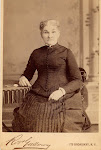


Last night we stayed over at Grandpa Jim Charnock’s house on Cinnamon Brow. Out in the kitchen his wife and our 3rd great-grandmother Elizabeth is cooking oatmeal for breakfast. We don't know much about her. We don't even know her last name. She said on several occasions that she was born in Upholland, but there is no marriage record for her in the Saint Thomas the Martyr Church there. That is the only record by which we can obtain her maiden name.
While we puzzle that problem over, let's learn a bit about our surroundings. Our map (attached, double click on photo to enlarge) shows that Cinnamon Brow is located on the south side of Upholland, near a fork in the road. One road leads down to the village proper, the other up on Cinnamon Brow. The cluster of homes up the ridge is where we are this morning. Now let’s learn more about Upholland from a tourist guide. Again we will use John Marius Wilson’s Imperial Gazetteer of England and Wales (1870-72) as a guide:
“UPHOLLAND is a township, village and ecclesiastical district in the parish of Wigan and Hundred of West Derby, four miles west from Wigan. The church is dedicated to Thomas a-Becket, and dates from the 14th century. It was formerly attached to a priory of Benedictines. There are registers from A.D. 1600. The living is of the annual value of £299. The Rev. F. D. Cremer has been recently appointed to the living. There are chapels for Wesleyans and Primitive Methodists. The village is situated near the summit and centre of the ridge of which Billinge and Ashurst Beacons are the termini, and there is the same extensive view. Lord Skelmersdale is Lord of the Manor. Here is a grammar school dating from 1668.” Another tourist of the time simply described Upholland as a charming village.
Our Grandpa Jim Charnock was up early this morning and already walked to work. Let's catch up with him. His job as engine tender requires that he be among the first men to come to work. The new work rules laid down by Parliament in 1857 required that “The engine tender shall always be at his engine in sufficient time before the hour fixed for the colliers [coalminers] to commence work, to enable him to have his engine ready to start, and to let down the person whose duty it may be to examine the state of the workings previously to the pit commencing work, and shall, before letting any person down, examine carefully the winding gear, and run the rope or chain once up and down the shaft ; and shall not permit more than eight persons to ascend or descend at the same time, nor let any person down the pit, in the absence of a banksman, nor leave the hand-gears whilst men are ascending or descending, except in case of immediate and urgent necessity,” (Rule: 5).
The overall responsibility of the engine tender was to move miners up-and-down the mineshaft safely; and a banksman was employed to help him do so. The banksman used flags connected to ropes and pulleys to signal the engine tender when the elevator was reaching the bottom of the shaft. Reaching the bottom safely was not a given in mines at that time, more than once elevators full of miners plunged to their deaths on the mine floor because either the signal or elevator mechanics didn't work properly. That is why we're only watching Grandpa Charnock from outside the engine house. “The engine tender shall not, except by special authority, allow any working collier or other person to be in the engine house for any purpose, nor without such authority shall he leave his engine in the charge of any other person,” (Rule: 7). While it might be tempting to say there was no Bring Your Son to Work Day for James, two of his sons William and John became engine tenders as well.
----------------
James Charnock died on Cinnamon Brow on February 14, 1857 at age 67. He died of bronchitis, which had been in an acute phase for five months. His wife Elizabeth died on Cinnamon Brow on May 26, 1867 at the age of 76. She died of hepatitis, which was under treatment for 10 days. Her certificate of death, which I incidentally received today, describes her as the widow of James Charnock, a master shoemaker. It appears that James had more than one occupation. And we will leave it at that for now.
---------------------
After an exhausting day at the mine, let’s walk in our new shoes 15 miles west to the city of Liverpool. We can rest up there before we tag along with Elizabeth Charnock and Stephen Walch on their journey to America.





No comments:
Post a Comment